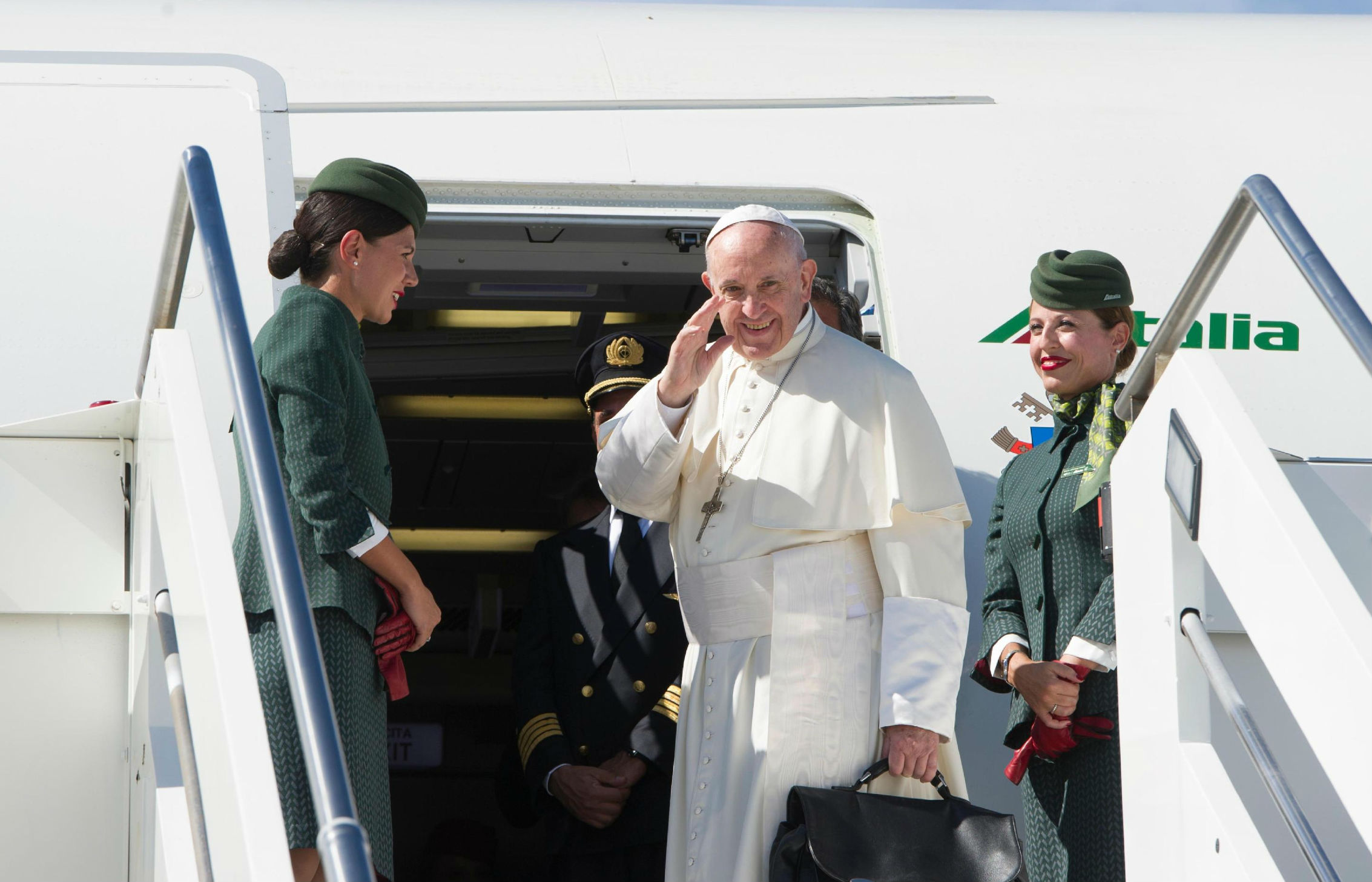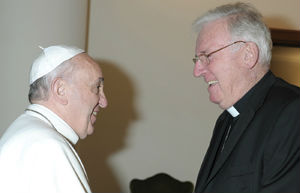At the conclusion of the 2005 conclave, Joseph Ratzinger emerged as Pope Benedict XVI; in 2013, the cardinals elected Jorge Bergoglio as Pope Francis. The one English cardinal present at the first of the two conclaves learned a lesson that was to prove decisive at the second
The hint dropped by Cardinal Cormac Murphy-O’Connor over drinks at the English College in the days prior to the 2005 conclave takes on a new significance, looking back. It was the first papal election in which all but two of the world’s 115 cardinals had ever taken part, and Murphy-O’Connor was at the heart of the buzz. Westminster was a kind of hub for the world’s English-speaking cardinals, and its tall, jovial archbishop was a point of reference for Africans and Asians as well as Americans. In conclave argot, Cormac was seen as a “kingmaker”.
At the time, I was his conduit to the world’s media, pressing at the window, so he was careful about giving away too much about which papabili were up and which were down. But, at the end of each day of the general congregations – the pre-conclave gatherings where, in sede vacante, the cardinals act as a kind of ruling council – if he wasn’t off to one of those college dinners where they took the measure of each other, he would sit with a gin and tonic and give me little steers. I’d mention a name and he would shake his head, or give an encouraging nod, but then make a movement of his hands as if to say: “Hmmm, not sure about him.”
“What do you know about the Latin Americans?” Cormac asked me one evening. Excited by the prospect of the papacy passing to that continent, I riffed on the two forerunners, the Brazilian social-justice Franciscan, Cláudio Hummes, and the Honduran firecracker, Oscar Rodríguez de Maradiaga, outlining for the Boss what I thought their strong points were. He cut me off.
“What about Buenos Aires?” he asked. “What do you know about him?” Not much, as it happened, beyond what I had picked up in the Argentinian capital three years earlier, when, as the economy was collapsing, the Jesuit archbishop had begun to emerge as a national figure. “Why?” I asked. “Is he being talked about?” Cormac nodded gravely, and gave me one of his wise-elder, “you-mark-my-words” looks.
Looking back, I realise that this was the only time in our chats in those days when he ever really lit up while mentioning a candidate. But he did so in such a reserved way that it didn’t quite register. What had made a bigger impact were his observations about the way Cardinal Joseph Ratzinger, as Dean of the College of Cardinals, was running the general congregations, skilfully melding the most heterogeneous, global and disparate bunch of red hats in the Church’s history. Although he never quite said as much, I twigged that this quality, in those circumstances, with the cardinals still in shock after the extraordinary drama of the death of Pope John Paul II, made the German cardinal – in the absence of any obvious challenger – a shoo-in for the fisherman’s shoes. So it proved.
Yet there had been a challenger. Later that year, an Italian cardinal published his conclave diary, revealing that the “progressives” around the Archbishop of Milan, Cardinal Carlo Maria Martini, whose Parkinson’s disease had ruled him out as papabile, had promoted and voted for Cardinal Jorge Mario Bergoglio. Cormac, it turned out, was part of this group. Months before, when I had learned that the cardinal was going off to meet other church leaders in St Gallen, Switzerland, I had assumed that this was for the Council of Episcopal Conferences of Europe (CCEE). Cormac had explained that it wasn’t quite that, but an informal group, which got together each year to discuss issues of mutual concern. It all sounded quite mysterious.
The “St Gallen group” had originally come together in the mid-1990s in response to Rome’s de-fanging of the CCEE. After the Vatican failed to bring it and the Latin American bishops’ council, Celam, under direct control of the synod secretariat, local meetings were steered in an attempt to turn these bodies into mechanisms for implementation rather than discernment. Celam, which was far older and bigger than the CCEE, could resist this rather better than the Europeans.
As Cardinal Godfried Danneels, emeritus of Brussels, has described in his authorised biography, the reformists, or pastoralists, in the CCEE decided to hold their own, off-the-radar meetings to do informally what they no longer could formally: discuss the state of the Church. The group of seven or eight cardinals – de facto led by Cardinal Martini, whom Cormac deeply admired – had included Basil Hume, and after 2001, Cormac. When he wrote in his memoirs, An English Spring, that “among some of the European cardinals in particular, there was a hankering for a more pastoral style, a longing for a shift of the focus of attention from the centre of the Church to the peripheries”, Cormac was summarising the essence of the St Gallen agenda.
It was a vision that had begun to emerge around the time of the consistory of 2001, when the Latin American red hats in the college suddenly swelled and made common cause with the European pastoralists, urging reform. This shift in the college in many ways was the origin of the Francis papacy. Cormac and Bergoglio, both made cardinals that year, would meet and talk at Vatican meetings, where they were usually seated together. The more Cormac knew Bergoglio, especially after 2005, the more he became convinced that he was the one to take the helm.
At the end of the Wojtyla pontificate, Cormac detected a division between the cardinals. With his pastor’s gift for scriptural metaphor, he described it as those who wanted a “leaven-in-the-mass” Church, on the one hand, and those who wanted a “city-on-the-hill” Church, on the other. It wasn’t so much about doctrine, he would insist, as about style and emphasis. Cormac was loyal to a fault. He believed the era of St John Paul II had been a necessary repackaging of the Catholic tradition in the light of the Second Vatican Council, one that avoided either rupture or resistance. But he felt strongly that a city-on-a-hill Church lacked credibility in a pluralist society in which the grammar of faith was slipping away.
The Church’s credibility had to come from its closeness to people, the vicinanza embodied by Gaudium et Spes and by the popes he most admired, St John XXIII and Blessed Paul VI. A papacy of condemnation more than dialogue, of endless proclamations rather than careful discernment, needed to give way to a pastoral papacy where the focus was on people, rather than ideas. None of this could happen without reforming the Curia, and the Polish pope’s lack of interest in doing so was a disappointment to Cormac. When the dysfunctions exploded on Benedict XVI’s watch, he was sad but not surprised.
In March 2013, Cormac was beyond the age at which he could take part in the conclave. However, he was very active in the meetings that led up to it. The St Gallen group had faded in 2006 but not its dream, and its members, many of them now emeriti, made their voices heard at the general congregations. Cormac had learned some lessons from 2005. He observed how the pro-Ratzinger team had gone about before the conclave promoting their man, so that by the time the conclave opened he had become the one to beat. Cormac believed that the next pope should have a heart for the poor, implement collegiality, reform the Curia, and, above all, be a pastor.
Convinced that this man was Bergoglio, Cormac toured the red-hat dinners and, as Catherine Pepinster reveals in her forthcoming book, The Keys and the Kingdom: the British and the Papacy from John Paul II to Francis, even co-hosted one of his own, for Commonwealth cardinals, at the British embassy, to ensure he was talked about, as Ratzinger’s partisans had done in 2005. The idea was to give the Argentinian a strong head start out of the starting block, with at least 25 votes on the first ballot. This was because conclaves essentially are an exercise in discerning between a few front-runners. Cormac was the chief organiser of this effort, assisted by the ancient emeritus of Florence, Silvano Piovanelli, who kept a tally of the cardinals likely to back Bergoglio. (Piovanelli died in 2016.)
All this was quite within the rules, which prohibit only secret agreements between candidates and their backers. “Team Bergoglio” was simply doing in 2013 what “Team Ratzinger” had done in 2005.
If Bergoglio knew what they were up to, he gave no indication. Anyway, as Cormac once described it, while the human process that precedes a papal election is important, what happens after the doors close on the conclave itself is the work of the Holy Spirit. More than one Latin American cardinal has told me how the election was the result of a prayerful convergence in the Sistine Chapel.
All were aware of the crisis in the Church and of the special need for the next Peter to be God’s choice. Because there was little doubt who that was, it took just four ballots. But Bergoglio did have, by all accounts, at least 25 votes at first scrutiny. Cormac was proud to have opened that channel for the Holy Spirit to get to work. He was ever the patient, moderate, cautious reformer, as he describes himself in An English Spring. But, when the time was right, he knew when and how to act boldly, deploying his energy and charm to smooth the path of providence.
At the moment of Francis’ election, he was in St Peter’s Square, weeping tears of joy. The whirlwind that followed was what he had dreamed of as a young priest. It was a film-script conclusion to a life of loving service.
Austen Ivereigh was press secretary and later advisor for public affairs to Cardinal Cormac Murphy-O’Connor between 2004 and 2006. He is the author of The Great Reformer: Francis and the Making of a Radical Pope.



 Loading ...
Loading ...